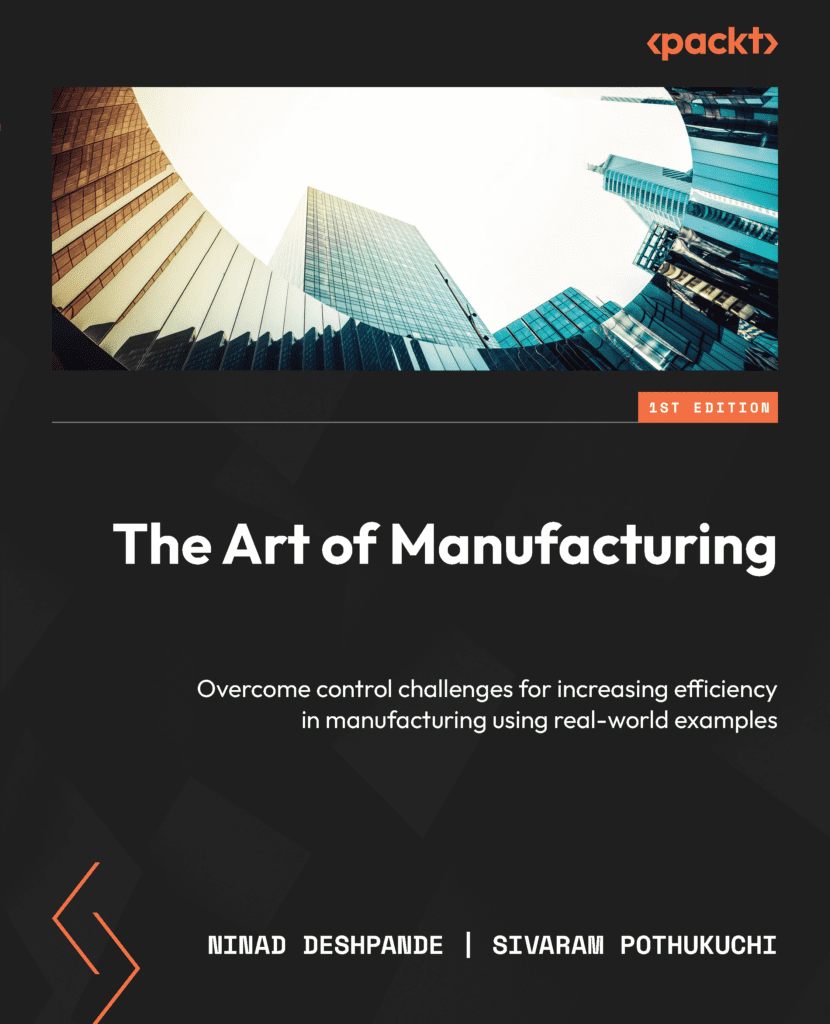Sivaram Pothukuchi is the author of The art of manufacturing, we got the chance to sit down with him and find out more about his experience of writing with Packt.
Q: What is/are your specialist tech area(s)?
Sivaram: Automation and Control, Process Control, Digitalisation, Machine, and Factory Automation.
Q: How did you become an author for Packt? Tell us about your journey. What was your motivation for writing this book?
Sivaram: This book has been emerging over a period of time. My career journey has been running alongside the evolution of automation in the manufacturing industry. I have been involved in offering solutions to customer problems in various branches of industry – plastics, packaging, textile machinery, pharma machinery, power plants, power transmission and distribution, and so on. The customer usually has a clear knowledge of the need statement; his pain points in the present scheme. The major challenge arises in providing a proposal of a solution architecture that would work in their context. As a part of this journey, I have developed a considerable amount of training curriculum and content. At some point, it became striking that young graduate engineers know mostly the theory of controls but hardly are aware of application examples. Even in the industry, we find that people’s knowledge of applications is restricted to their own personal experiences. So it has been my ambition to write a book starting with the application use cases at the center.
Q: What kind of research did you do, and how long did you spend researching before beginning the book?
Sivaram: It might sound funny, but the book was already in my mind by the time we started writing the book. The real research was performed at the time of imparting training to customer engineers and to new recruits in-house. Every sales meeting and every training session can also be useful as an opportunity to gain insights into the field of applications. The gaps in knowledge which were observed, form the basis for this book.
Q: Did you face any challenges during the writing process? How did you overcome them?
Sivaram: The first big challenge any writer faces is putting his/her thoughts in a sequence. In a subject matter which is my own area of expertise, the thoughts come all in a rush. So a good strategy here is to jot down ideas briefly as sort of bullet points – paragraph headings if you like. Then it is easier to sort them in a logical sequence, and also to remove ideas that do not fall in the same line. One should frequently place oneself in the shoes of a possible reader. Then carry on an imaginary conversation in form of a question and answer. The answers will give the sequence. Having a knowledgeable co-author to nudge, guide and help over periods of the block is a great help.
Q: What’s your take on the technologies discussed in the book? Where do you see these technologies heading in the future?
Sivaram: Actually we discuss solutions and not specific technologies. Of course solutions make use of technology. A solution scheme would be strongly influenced by the technologies available on the date. More than just available, they should be affordable. More than just being affordable, they should be at a level that they can be managed by human resources – not just while installation and commissioning, but through the life-cycle. The solutions we have described in this book are very robust and fundamentally survived over a couple of generations of technological changes. And, I am sure will also be useful over the next couple of generations of technologies.
Q. Why should readers choose this book over others already on the market? How would you differentiate your book from its competition?
Sivaram: Our book is very unique in its uptake. We start with a statement of an industry problem and work our way through the solution strategy to the theory. The theory is explained to the extent that it proves that the solution would work. We do not dwell on mathematics and physics which are covered at the textbook level. This book is rather an experienced practitioner giving out answers to the questions which arose to the authors when they were students themselves.
Q. What are the key takeaways you want readers to come away from the book with?
Sivaram: The main and most important takeaway is to start with a rigorous formulation of the requirement statement itself. The more clearly articulated the requirement becomes, the more it is easier to get a solution that will be the first time right.
Q. What advice would you give to readers learning tech? Do you have any top tips?
Sivaram: This book is for people who want to build a better mousetrap. That means people who are ready to innovate and find a more efficient way of solving a problem that has been around for so long. So my tip would be – close your eyes and try to imagine the machine working, and what is an annoyance or inefficiency which strikes you strongly? From that point, you can work towards which application example gives you a good way forward.
Q. Do you have a blog that readers can follow??
Sivaram: Nothing as of now.
Q. Can you share any blogs, websites, and forums to help readers gain a holistic view of the tech they are learning?
Sivaram: There are several forums, some of which belong to the vendor companies of automation. The best resource according to me would be the site of ISA – International Society of Automation www.isa.org
Q. How would you describe your author journey with Packt? Would you recommend Packt to aspiring authors?
Sivaram: Packt Editorial team is very collaborative and supportive. They first help you by breaking down the task into smaller portions and creating a timeline together. They are knowledgeable and work in a partnership mode, more by nudging and suggesting than by bullying. A good experience indeed, particularly considering that I am a first-time author!
Q. Do you belong to any tech community groups?
Sivaram: No.
Q. What are your favorite tech journals? How do you keep yourself up to date on tech?
Sivaram: My means of staying up-to-date is interaction with customers from the past and from today. I write a monthly column for an automation journal – Industrial Automation: https://www.industrialautomationindia.in/
Q. How did you organize, plan, and prioritize your work and write the book?
Sivaram: Even if the subject matter is very familiar, putting the matter into writing is creative work. Primarily one must imagine the mind of the reader and plan what thoughts or ideas one wants to provoke in the reader. The main aspect of writing is to get into the frame of mind. The ideas occur spontaneously and randomly even during the course of regular activities. It is useful to jot down such ideas in a separate notebook as and when they occur.
Q. What is the one writing tip that you found most crucial and would like to share with aspiring authors?
Sivaram: The problem which besets all authors is the periods of ‘pause’ where the mind goes blank, and it is difficult to move forward. One tip which I can share is brutal self-discipline – force yourself to write five hundred words every day, no matter what you write.
You can find Sivaram’s book on Amazon by following this link: Please click here








